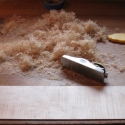
I am varnishing the cello we’ve been following right now. This ends up giving me a bit of time in between coats to work on other things. So, I have started the next cello. More about varnish later.
Ribs are the sides of the instrument. They are what gives the air volume to a cello’s resonating body. The height of the ribs has a big affect on the sound of the instrument, for this reason. Ribs are very thin, cello ribs being about 1.5-1.7 mm thick and violin ribs being around 1 mm thick (1 mm is about the thickness of ten sheets of copier paper). Cello ribs in particular take a lot of abuse over the life of an instrument. It’s quite common to see old cellos with many rib cracks, in fact I worked on a cello that had 100 rib cracks, I counted. I spent a couple of months just cleaning and gluing all of them. All of the parts of the body of an instrument are relatively thin and fragile on their own but the violin is an amazing structure because when you put the component parts together they are very strong.
I start making a rib structure with a mold. A mold is a form that provides shape to the rib structure until it is done. Molds can be used over and over, in fact we still have some of the molds from the Stradivari workshop that have survived. My mold is plywood because it is light and stable and I drill holes in it to make it lighter still.

There are six blocks in an instrument; one at each of the four corners, one for the neck to attach to and one at the endpin. In this case I am using willow for my blocks, but many types of wood can be used. It seems like classic makers used whatever was light ,strong and handy. The blocks are squared up and spot glued to the mold, so they will stay put but be able to be released later.
Then I thickness the ribs. I cut them close to thickness with a bandsaw and then I plane then down to thickness by hand. I use a block plane with a toothed blade in it. A toothed blade is less likely to tear out the flames on the maple.
When the ribs are very close to thickness I finish them with a cabinet scraper to remove the grooves left from the toothed blade. Sometimes I choose to leave a bit of the texture from the plane, as I have seen this on a few old instruments and I like the look if it’s subtle.









